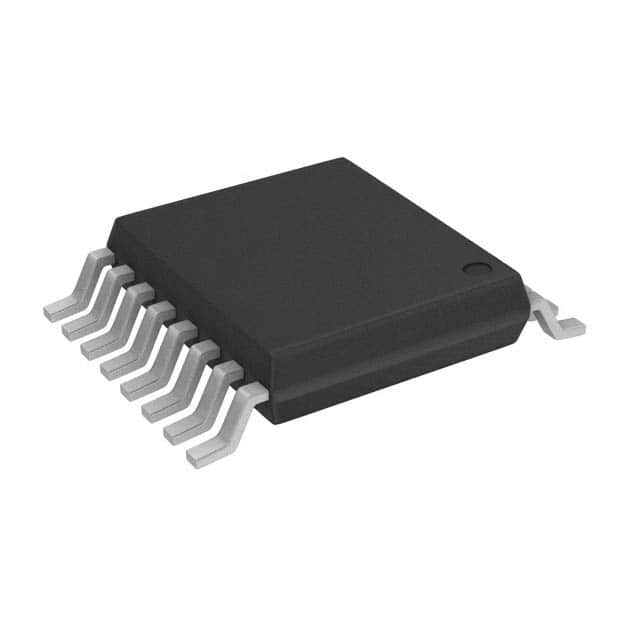MC908QL4MDTER
Product Overview
Category: Microcontroller
Use: Embedded systems, automotive applications
Characteristics: Low power consumption, high performance, integrated peripherals
Package: 64-pin LQFP (Low Profile Quad Flat Package)
Essence: A microcontroller designed for automotive applications
Packaging/Quantity: Individually packaged, quantity varies based on supplier
Specifications
- Architecture: 8-bit
- CPU Speed: Up to 8 MHz
- Flash Memory: 32 KB
- RAM: 2 KB
- Operating Voltage: 2.7V to 5.5V
- Operating Temperature Range: -40°C to +125°C
- Number of I/O Pins: 52
- Communication Interfaces: SPI, SCI, I2C
- Analog-to-Digital Converter (ADC): 10-bit, 8 channels
- Timers/Counters: 2 x 16-bit, 1 x 8-bit
- Watchdog Timer: Yes
- Interrupts: 32
Detailed Pin Configuration
The MC908QL4MDTER microcontroller has a total of 64 pins. The pin configuration is as follows:
- Pins 1-8: Port A (I/O)
- Pins 9-16: Port B (I/O)
- Pins 17-24: Port C (I/O)
- Pins 25-32: Port D (I/O)
- Pins 33-40: Port E (I/O)
- Pins 41-48: Port F (I/O)
- Pins 49-56: Port G (I/O)
- Pins 57-60: VDD, VSS, RESET, IRQ
- Pins 61-64: Oscillator and clock related pins
Functional Features
- Low power consumption for automotive applications
- High-performance 8-bit CPU
- Integrated peripherals such as ADC, timers/counters, and communication interfaces
- Wide operating voltage range for flexibility
- Extended temperature range for harsh environments
- Multiple I/O pins for interfacing with external devices
- Watchdog timer for system reliability
- Interrupts for efficient event handling
Advantages and Disadvantages
Advantages: - Low power consumption makes it suitable for battery-powered applications - Integrated peripherals reduce the need for external components - Wide operating voltage range allows for compatibility with various power sources - Extended temperature range ensures reliable operation in extreme conditions - Ample I/O pins provide flexibility in system design - Watchdog timer enhances system reliability - Interrupts enable efficient event handling
Disadvantages: - Limited flash memory and RAM compared to higher-end microcontrollers - 8-bit architecture may not be sufficient for complex applications - Limited number of communication interfaces compared to some other microcontrollers
Working Principles
The MC908QL4MDTER microcontroller operates based on an 8-bit architecture. It executes instructions stored in its flash memory and utilizes its integrated peripherals to perform various tasks. The CPU communicates with external devices through its I/O pins and interfaces such as SPI, SCI, and I2C. The microcontroller can be programmed using appropriate software tools to control and monitor connected systems.
Detailed Application Field Plans
The MC908QL4MDTER microcontroller is primarily designed for automotive applications. It can be used in various automotive systems, including engine control units, body control modules, instrument clusters, and more. Its low power consumption, high performance, and integrated peripherals make it suitable for controlling and monitoring different aspects of a vehicle's functionality.
Detailed and Complete Alternative Models
- MC9S08QG8: 8-bit microcontroller with similar features but lower flash memory and fewer I/O pins
- MC9S08DZ60: 8-bit microcontroller with higher flash memory, more I/O pins, and additional communication interfaces
- MC9S08AW60: 8-bit microcontroller with higher flash memory, more RAM, and additional peripherals
These alternative models offer different specifications and features, allowing users to choose the most suitable microcontroller for their specific application requirements.
Word count: 460 words
技術ソリューションにおける MC908QL4MDTER の適用に関連する 10 件の一般的な質問と回答をリストします。
Sure! Here are 10 common questions and answers related to the application of MC908QL4MDTER in technical solutions:
Q: What is MC908QL4MDTER? A: MC908QL4MDTER is a microcontroller from NXP Semiconductors, specifically designed for embedded control applications.
Q: What are the key features of MC908QL4MDTER? A: Some key features include a 8-bit CPU core, flash memory, RAM, analog-to-digital converters, timers, and communication interfaces.
Q: What are the typical applications of MC908QL4MDTER? A: MC908QL4MDTER is commonly used in various technical solutions such as industrial automation, automotive systems, consumer electronics, and medical devices.
Q: How can I program MC908QL4MDTER? A: MC908QL4MDTER can be programmed using assembly language or high-level programming languages like C/C++. Development tools like IDEs and debuggers are available for this purpose.
Q: Can MC908QL4MDTER communicate with other devices? A: Yes, MC908QL4MDTER supports various communication interfaces like UART, SPI, I2C, and CAN, allowing it to communicate with other devices or peripherals.
Q: What is the power supply requirement for MC908QL4MDTER? A: MC908QL4MDTER typically operates at a voltage range of 2.7V to 5.5V, making it compatible with a wide range of power supply options.
Q: Does MC908QL4MDTER have any built-in security features? A: Yes, MC908QL4MDTER provides security features like hardware encryption, secure boot, and tamper detection, ensuring the integrity and confidentiality of data.
Q: Can MC908QL4MDTER handle real-time applications? A: Yes, MC908QL4MDTER is capable of handling real-time applications due to its fast execution speed, interrupt handling capabilities, and timers.
Q: Is MC908QL4MDTER suitable for low-power applications? A: Yes, MC908QL4MDTER has power-saving features like multiple low-power modes, allowing it to be used in battery-powered or energy-efficient applications.
Q: Are there any development resources available for MC908QL4MDTER? A: Yes, NXP provides comprehensive documentation, datasheets, application notes, and software libraries to assist developers in utilizing MC908QL4MDTER effectively.
Please note that the answers provided here are general and may vary depending on specific requirements and use cases.


